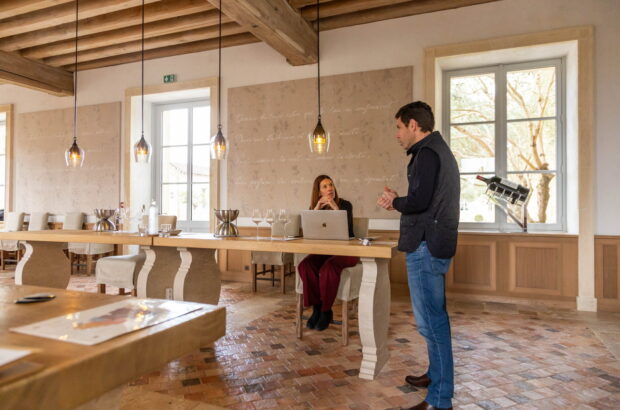Sangiovese, the grape responsible for Brunello, Chianti Classico and a host of other wines, is scorned and applauded in equal measure. With over 55,000ha it’s Italy’s most-planted red variety, taking up around 8% of its total vineyard area, with the enormity of this number suggesting that wherever it is planted, it thrives.
That is a misconception, which is fuelled further by the fact that the variety, on its own or in blends, features in a staggering 112 denominations and 88 IGTs, Italy’s equivalent of Vin de Pays with geographical indication. Sangiovese’s omnipresence has perpetuated the erroneous idea that Sangiovese must be easy to grow and easy to vinify, but many mediocre wines suggest the opposite.
Like no other grape, Sangiovese is extremely sensitive when it comes to site specifics. It demands the best spot on poor, rocky soils, while its growth needs to be tamed in order to produce quality. Demands that were not always recognised or met in the recent past.
In particular, it is Sangiovese’s vigour and the frustratingly variable quality that got it into trouble. The variety is capable of producing lots of large, big bunches if it is left to its own devices. Disastrously, even more generously producing clones were introduced in the past, leading to tart and tannic wines.
{"content":"PHA+VGhlIG1pc2NvbmNlcHRpb24gb2YgU2FuZ2lvdmVzZSBiZWluZyBhIG1lZGlvY3JlIHZhcmlldHkgdGhhdCBuZWVkcyB0byBiZSBpbXByb3ZlZCwgb3Ig4oCYYW1lbGlvcmF0ZWTigJkg4oCTwqBhcyBJdGFsaWFuIHdpbmUgbGF3IGRlcm9nYXRvcmlseSBhbmQgZmFsc2VseSBkZXNjcmliZXMgdGhlIGxlZ2FsIGFkZGl0aW9uIG9mIG90aGVyIHZhcmlldGllcywgbW9zdGx5IE1lcmxvdCBhbmQgQ2FiZXJuZXQgU2F1dmlnbm9uIOKAkyBlbnN1ZWQuIFRoZXNlIGludGVybmF0aW9uYWwgaW50ZXJsb3BlcnMsIGluIGNvbWJpbmF0aW9uIHdpdGggdGhlIHByYWN0aWNlIG9mIGFnZWluZyB0aGUgZW5zdWluZyBibGVuZHMgaW4gYmFycmlxdWVzLCBvYnNjdXJlZCBleGFjdGx5IHRob3NlIGNoYXJhY3RlcmlzdGljcyB0aGF0IHRydWUgU2FuZ2lvdmVzZSBwb3NzZXNzZXM6IHZpYnJhbmN5LCBlbGVnYW5jZSBhbmQgdHJhbnNwYXJlbmN5LiBCYWNrIGluIHRoZSAxOTgwcyBhbmQgMTk5MHMsIGhvd2V2ZXIsIHBvd2VyZnVsIGFuZCBkZWVwbHkgY29sb3VyZWQgd2luZXMgd2VyZSBpbiB3aWRlIGRlbWFuZC48L3A+CjxwPjxkaXYgY2xhc3M9ImFkLWNvbnRhaW5lciBhZC1jb250YWluZXItLW1vYmlsZSI+PGRpdiBpZD0icG9zdC1pbmxpbmUtMiIgY2xhc3M9ImlwYy1hZHZlcnQiPjwvZGl2PjwvZGl2PjwvcD4KPGgzPkNoYW5naW5nIGF0dGl0dWRlczwvaDM+CjxwPldpdGggZmV3IGV4Y2VwdGlvbnMsIFNhbmdpb3Zlc2UgcmVtYWluZWQgYSBsaXR0bGUtbG92ZWQgZ3JhcGUuIEJ1dCBpbiB0aGUgbGFzdCAxMCB5ZWFycyBvciBzbyBpbiBJdGFseSBhIHdob2xlc2FsZSBjaGFuZ2UgdG93YXJkcyBTYW5naW92ZXNlLCBpbiBvcGluaW9uIGFzIHdlbGwgYXMgc3R5bGUsIGhhcyBiZWd1biB0byBtYW5pZmVzdCBpdHNlbGYgc28gc3Ryb25nbHksIGl0IGhhcyBiZWNvbWUgaW1wb3NzaWJsZSB0byBpZ25vcmUgYW55IGxvbmdlci48L3A+CjxwPlByb2R1Y2VycyBoYXZlIHN0YXJ0ZWQgdG8gZGlzbWlzcyBpbnRlcm5hdGlvbmFsIHZhcmlldGllcyBpbiBmYXZvdXIgb2YgdXNpbmcgMTAwJSBTYW5naW92ZXNlLCBvciBibGVuZGluZyBpdCBvbmx5IHdpdGggaW5kaWdlbm91cyBJdGFsaWFuIHZhcmlldGllcywgd2hpbGUgYnJpc3RsaW5nIGF0IHRoZSB1c2Ugb2YgYmFycmlxdWVzLiBJbnRlbnNlIHNjcnV0aW55IG9mIHRoZSB2YXJpZXR5IGluIHRoZSB2aW5leWFyZCBhbmQgaW52ZXN0aWdhdGlvbiBpbiBtYXRjaGluZyB0aGUgcmlnaHQgY2xvbmVzIHRvIHZhcmlvdXMgc29pbCB0eXBlcywgcGx1cyBhIHZlcnkgZ2VudGxlIGhhbmQgaW4gd2luZW1ha2luZyByZXZlYWxlZCBhIHdob2xlIGRpZmZlcmVudCBzaWRlIG9mIFNhbmdpb3Zlc2UuPC9wPgo8cD5Ob3RhYmx5IGluIENoaWFudGkgQ2xhc3NpY28gdGhpcyB0cmVuZCBtYW5pZmVzdGVkIGl0c2VsZiBzdHJvbmdseSwgd2hlcmUgdGhlIGNhcGFiaWxpdHkgb2YgU2FuZ2lvdmVzZSB0byBleHByZXNzIG9yaWdpbiBiZWNhbWUgdGhlIGZvY3VzIG9mIGEgbmV3IGdlbmVyYXRpb24gb2YgcHJvZHVjZXJzLCB0YWtpbmcgaXRzIGxlYWQgZnJvbSB3aGF0IHdlcmUgb25jZSBjb25zaWRlcmVkIGFyY2gtdHJhZGl0aW9uYWxpc3RzIGFuZCBwcmV2aW91c2x5IGRpc21pc3NlZCBhcyBob3BlbGVzc2x5IG9sZC1mYXNoaW9uZWQuIE9uY2UgdGhlIFN1cGVyIFR1c2NhbiBmb3JtdWxhIG9mIGludGVybmF0aW9uYWxseSBzdHlsZWQsIGNvbmNlbnRyYXRlZCB3aW5lcyBiZWdhbiB0byBzdWJzaWRlLCB0aGUgdHJ1ZSBTYW5naW92ZXNlIHN0YXJ0ZWQgdG8gZW1lcmdlLjwvcD4KPGRpdiBjbGFzcz0iYWQtY29udGFpbmVyIGFkLWNvbnRhaW5lci0tbW9iaWxlIj48ZGl2IGlkPSJwb3N0LWlubGluZS0zIiBjbGFzcz0iaXBjLWFkdmVydCI+PC9kaXY+PC9kaXY+CjxwPkluIE1vbnRhbGNpbm8sIHdoZXJlIEJydW5lbGxvIG11c3QgYmUgMTAwJSBTYW5naW92ZXNlLCBhIHNpbWlsYXIgdGhpbmcgaGFwcGVuZWQuIFRoZSBkZW5vbWluYXRpb24gaGFkIGJlZW4gb3ZlcnNoYWRvd2VkIGJ5IHRoZSBCcnVuZWxsbyBzY2FuZGFsIGFyb3VuZCAyMDA4LiBJcm9uaWNhbGx5LCB0aGUgc2NhbmRhbCBjb3VsZG7igJl0IGhhdmUgYmVlbiB0aW1lbGllciwgYmVjYXVzZSB0aGUgZGViYXRlIGFuZCBzb3VsLXNlYXJjaGluZyBpdCB0cmlnZ2VyZWQgaGFzIGxlZCBhd2F5IGZyb20gYSBzdHJpY3Qgd2luZW1ha2luZyBhcHByb2FjaCB0byBhIHJlbmV3ZWQgZm9jdXMgb24gdGhlIHZpbmV5YXJkLCB3aGlsZSBmdWVsbGluZyBkZWJhdGVzIGFuZCBhcmd1bWVudHMgb24gd2hhdCB0aGUgYmVzdCB0ZXJyb2lycyBpbiB0aGUgZGVub21pbmF0aW9ucyByZWFsbHkgYXJlLjwvcD4KPHA+SW4gbXkgb3BpbmlvbiwgYSBtdWNoIG1vcmUgaW1wb3J0YW50IGVmZmVjdCBpcyB0aGF0IHNpbmNlIDIwMDggdGhlIHJlZ2lvbiBoYXMgYmVndW4gdG8gbW92ZSBhd2F5IGZyb20gYSBkb21pbmFudCBzdHlsZSB0aGF0IHByb2R1Y2VycyBiZWxpZXZlZCB0aGUgaW50ZXJuYXRpb25hbCBtYXJrZXQgZGVtYW5kZWQsIGFuZCB0b3dhcmRzIGEgc3R5bGUgdGhhdOKAmXMgY2VudHJlZCBvbiB0aGUgaWRlbnRpZmljYXRpb24gb2Ygc3ViLXpvbmVzLiBUaGlzIGhhcyByZXN1bHRlZCBpbiBhIHBsZXRob3JhIG9mIHN0eWxlcy4gQSBncm93aW5nIHRyZW5kIGZvciBzaW5nbGUgdmluZXlhcmQgd2luZXMgaXMgcHJvb2YgZm9yIHRoZSBmYWN0IHRoYXQgYSBzeXN0ZW0gb2Ygc3ViLXpvbmVzLCByYXRoZXIgdGhhbiBzaW5nbGluZyBvdXQgb25lIHN1Yi16b25lIG92ZXIgb3RoZXJzLCBpcyB0aGUgd2F5IGZvcndhcmQsIGV2ZW4gaWYgdGhlIHJlZ2lvbiBpdHNlbGYgaXMgc2xvdyB0byBhY2NlcHQgdGhpcyBmYWN0LjwvcD4KPGRpdiBjbGFzcz0iYWQtY29udGFpbmVyIGFkLWNvbnRhaW5lci0tbW9iaWxlIj48ZGl2IGlkPSJwb3N0LWlubGluZS00IiBjbGFzcz0iaXBjLWFkdmVydCI+PC9kaXY+PC9kaXY+CjxoMz5JbiBzZWFyY2ggb2YgcXVhbGl0eTwvaDM+CjxwPkV4Y2l0aW5nIGRldmVsb3BtZW50cyBhcmUgYWxzbyBoYXBwZW5pbmcgaW4gdGhlIFJvbWFnbmEgcmVnaW9uLCB3aGVyZSBTYW5naW92ZXNlIGhhcyB0cmFkaXRpb25hbGx5IGJlZW4gdXNlZCB0byBmaWxsIHRoZSBlbm9ybW91cyB0YW5rcyBvZiB0aGUgYXJlYeKAmXMgbWFueSBjby1vcHMsIG1ldCBieSBzb21lIG9mIHRoZSBsb3dlc3QgcHJpY2VzIHBhaWQgaW4gSXRhbHkgZm9yIGEga2lsbyBvZiBncmFwZXMuIExvdyBwcmljZXMgcHJldmVudGVkIG11Y2gtbmVlZGVkIGludmVzdG1lbnRzLCB3aXRoIG9ubHkgYSBoYW5kZnVsIG9mIHF1YWxpdHktZm9jdXNlZCBlc3RhdGVzIGxlZnQgdG8gZGVmZW5kIFJvbWFnbmHigJlzIHVuaXF1ZSB0ZXJyb2lycyBhbmQgcmVwdXRhdGlvbi48L3A+CjxwPkEgc2Vpc21pYyBjaGFuZ2UgaGFzIGJlZW4gaGFwcGVuaW5nIGhlcmUsIHRvby4gQSBjb2xsZWN0aXZlIG9mIHByb2R1Y2VycyBpbiBNb2RpZ2xpYW5hLCBpbiB0aGUgaGlsbHMgbmVhciBGYWVuemEsIGhhcyBiZWd1biBwcm9kdWNpbmcgd2luZXMgb2YgZWxlZ2FuY2UgYW5kIHRyYW5zcGFyZW5jeSwgZGVtb25zdHJhdGluZyB0aGF0IFJvbWFnbmEgU2FuZ2lvdmVzZSBET0MgaXMgYSBzdHlsZSBhbGwgb2YgaXRzIG93bi48L3A+CjxkaXYgY2xhc3M9ImFkLWNvbnRhaW5lciBhZC1jb250YWluZXItLW1vYmlsZSI+PGRpdiBpZD0icG9zdC1pbmxpbmUtNSIgY2xhc3M9ImlwYy1hZHZlcnQiPjwvZGl2PjwvZGl2Pgo8cD5JbiBiZXR3ZWVuIHRoZXNlIGJyb2FkIHJlZ2lvbmFsIGNoYW5nZXMgYXJlIHRoZSBuZXdjb21lcnMgYW5kIHJlYmVscywgbWFuYWdpbmcgdGhlaXIgdmluZXlhcmRzIG9yZ2FuaWNhbGx5IGFuZCB1c2luZyB3aW5lbWFraW5nIG1ldGhvZHMgbW9yZSBjb21tb25seSBhc3NvY2lhdGVkIHdpdGggUGlub3QgTm9pcjogd2hvbGUgYnVuY2ggZmVybWVudGF0aW9uIHVzaW5nIGluZGlnZW5vdXMgeWVhc3QsIHB1bmNoaW5nIGRvd24gYXMgdGhlIG1haW4gZXh0cmFjdGlvbiBtZXRob2QgYW5kIGFnZWluZyB0aGVpciBTYW5naW92ZXNlIGluIGFueXRoaW5nIGJ1dCBiYXJyaXF1ZS48L3A+CjxwPlRpbWUgYW5kIGFnYWluIHRoZWlyIHdpbmVzIGFyZSByZWplY3RlZCBieSB0aGUgb2ZmaWNpYWwgY29udHJvbCBzeXN0ZW0gYXMg4oCYdW50eXBpY2Fs4oCZLiBUaGV5IGFyZSB0aHJvd24gb3V0IG9mIHRoZSBhcHBlbGxhdGlvbiBzeXN0ZW0sIHN1Y2ggYXMgQ2hpYW50aSBDbGFzc2ljbywgYW5kIGluc3RlYWQgaGF2ZSB0byByZXNpZGUgdW5kZXIgdGhlIGxvd2x5IElHVCBUb3NjYW5hIGNhdGVnb3J5LjwvcD4KPHA+SW4gYWN0dWFsIGZhY3QsIHRoZXNlIHdpbmVzIGFyZSBzb21lIG9mIHRoZSBiZXN0IHRoYXQgYXJlIGN1cnJlbnRseSBwcm9kdWNlZCBpbiB0aGUgd2hvbGUgb2YgSXRhbHksIGFuZCBhcmUgb2Z0ZW4gaW5zcGlyZWQgYnkgZXN0YXRlcyBzdWNoIGFzIENhc3RlbGzigJlpbiBWaWxsYSBpbiBDaGlhbnRpIENsYXNzaWNvIGFuZCBCaW9uZGktU2FudGkgaW4gTW9udGFsY2lubyB0aGF0IG5ldmVyIHN1Y2N1bWJlZCB0byBhbnkgZmFzaGlvbiBvciB0cmVuZC48L3A+CjxoMz5UaGUgUkVTRVQgdGFzdGluZzwvaDM+CjxkaXYgY2xhc3M9ImluamVjdGlvbiI+PC9kaXY+CjxwPkluIG9yZGVyIHRvIHNob3djYXNlIGFsbCBvZiB0aGUgY2hhbmdlcyB0aGF0IFNhbmdpb3Zlc2UgaGFzIGdvbmUgdGhyb3VnaCDigJMgaW4gYm90aCBwZXJjZXB0aW9uIGFzIHdlbGwgYXMgdHJlYXRtZW50IOKAkyBKYW5lIEh1bnQgTVcgYW5kIEkgb3JnYW5pc2VkIGEgbGFyZ2Utc2NhbGUgdGFzdGluZyBpbiBMb25kb24gY2FsbGVkIFNhbmdpb3Zlc2UgUkVTRVQuIEFpbWluZyB0byBjZWxlYnJhdGUgdGhlIHJlbmFpc3NhbmNlIG9mIHRoZSBncmFwZSBhbmQgcmVzZXQgaXRzIGltYWdlLCB0aGUgdGFzdGluZyBmZWF0dXJlZCA4NyBvZiB0aGUgYmVzdCBwcm9kdWNlcnMgbWFzdGVyaW5nIHRoaXMgZ3JlYXQgZ3JhcGUgdmFyaWV0eS4gVGhlIGZvbGxvd2luZyAzMCB3aW5lcyBhcmUgYSB0aW55IHNlbGVjdGlvbiBvZiB0aGF0IHRhc3RpbmcsIGJ1dCB0aGV5IGRlbW9uc3RyYXRlIHRoZSBncmVhdG5lc3Mgb2YgU2FuZ2lvdmVzZS48L3A+CjxwPgo="}
Walter Speller’s Best Sangiovese wines
{}
{"wineId":"39174","displayCase":"standard","paywall":true}
{"wineId":"38352","displayCase":"standard","paywall":true}
{"wineId":"38355","displayCase":"standard","paywall":true}
{"wineId":"39179","displayCase":"standard","paywall":true}
{"wineId":"38034","displayCase":"standard","paywall":true}
{"wineId":"39180","displayCase":"standard","paywall":true}
{"wineId":"39181","displayCase":"standard","paywall":true}
{"wineId":"39167","displayCase":"standard","paywall":true}
{"wineId":"39170","displayCase":"standard","paywall":true}
{"wineId":"38364","displayCase":"standard","paywall":true}
{"wineId":"39183","displayCase":"standard","paywall":true}
{"wineId":"39182","displayCase":"standard","paywall":true}
{"wineId":"39177","displayCase":"standard","paywall":true}
{"wineId":"38043","displayCase":"standard","paywall":true}
{"wineId":"39178","displayCase":"standard","paywall":true}
{"wineId":"38036","displayCase":"standard","paywall":true}
{"wineId":"39186","displayCase":"standard","paywall":true}
{"wineId":"39164","displayCase":"standard","paywall":true}
{"wineId":"39169","displayCase":"standard","paywall":true}
{"wineId":"39171","displayCase":"standard","paywall":true}
{"wineId":"39184","displayCase":"standard","paywall":true}
{"wineId":"39185","displayCase":"standard","paywall":true}
{"wineId":"39176","displayCase":"standard","paywall":true}
{"wineId":"38383","displayCase":"standard","paywall":true}
{"wineId":"39165","displayCase":"standard","paywall":true}
{"wineId":"39166","displayCase":"standard","paywall":true}
{"wineId":"39168","displayCase":"standard","paywall":true}
{"wineId":"39172","displayCase":"standard","paywall":true}
{"wineId":"39173","displayCase":"standard","paywall":true}
{"wineId":"39175","displayCase":"standard","paywall":true}
{}












